|
Report from
Europe
EU27 tropical wood import value at highest level
since financial crisis
Between April and June this year, EU27 import value of
tropical wood and wood furniture products was, in dollar
terms, at the highest quarterly level since at least before
the 2007-2008 financial crisis (Chart 1). Imports of
US$1.27B during the second quarter of 2022 were 11%
more than the previous quarter and 25% more than the
same quarter the previous year.
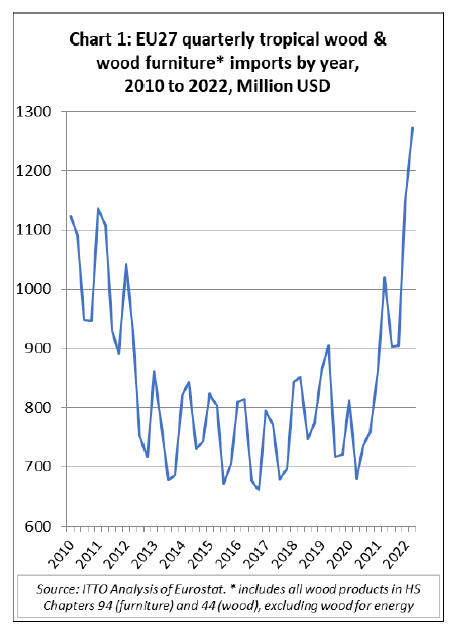
In the first six months of this year, import value of tropical
wood and wood furniture totalled US$2.42B, a gain of
29% compared to the same period last year. Part of the
gain in EU27 tropical wood product import value was due
to a rise in CIF prices. This was driven by the combination
of a sharp fall in the value of the euro against the dollar,
continuing high freight rates, and severe shortages of
wood and other materials. In quantity terms, EU imports
of tropical wood and wood furniture products in the first
six months of this year were, at 1,025,300 tonnes, up 15%
compared to the same period in 2021.
Since the start of this year, the euro value has declined
around 10% against the US dollar and is currently at the
lowest level for 20 years. In mid-July, the euro hit parity
with the US currency for the first time since 2002. The
euro¡¯s slide underlines the foreboding in the 19 European
countries using the currency as they struggle with an
energy crisis caused by Russia¡¯s war in Ukraine.
Usually such a sharp decline in the value of the European
currency would lead to a reduction in imports as prices for
goods from outside the EU escalated. However, this time it
is different as importers and manufacturers are struggling
in the face of critical wood supply shortages brought on by
the lingering effects of the global pandemic and the more
recent impact of the war in Ukraine. Importers have been
more willing to follow the prices upwards than in previous
periods of currency weakness.
The curtailment of wood supplies from Russia and Belarus
due to the sanctions imposed by the EU following the
invasion of Ukraine in February is opening up new
opportunities in the EU market for some tropical wood
products, notably plywood and decking for which Russian
birch and larch products have been important substitutes.
In the first six months of this year, tropical products
accounted for 8.8% of the quantity of all wood and wood
furniture products imported into the EU27, which
compares to 6.8% during the same period in both 2021 and
2020.
The gain in tropical wood share is due mainly to a large
reduction in imports from Russia (-50% to 2.19 million
tonnes) and Belarus (-26% to 1.31 million tonnes) during
this period. After an initial fall in the early months of the
war, EU27 imports from Ukraine recovered some ground
in the second quarter and by the end of the first six months
of this year were, at 1.03 million tonnes, only 1% down on
the same period in 2021 (Chart 2).
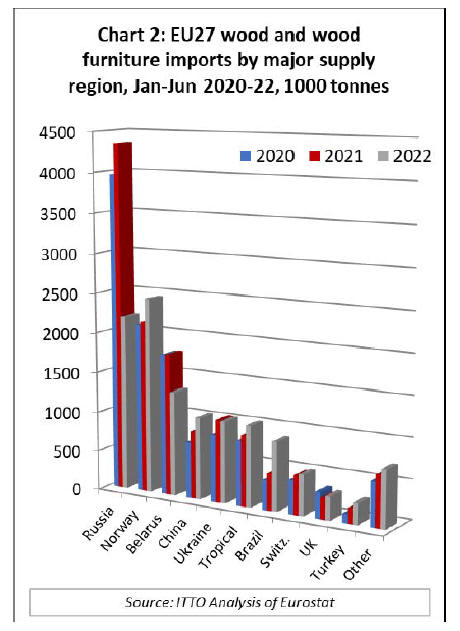
While tropical wood has made gains in the EU market this
year, the largest beneficiaries of the opening supply gap
due to the fall in imports from Russia and Belarus have
been non-tropical wood products from Norway (+14% to
US$2.45B), China (+21% to US$1.03B), Brazil (+86% to
US$867M), Turkey (+37% to US$263M), Chile (+52% to
US$54M), New Zealand (+31% to US$31M), Uruguay
(+242% to US$23M), and South Africa (+154% to
US$8M).
Rise in EU27 import value across all tropical wood
product groups
Nevertheless, there were significant increases in the value
of EU27 imports of most wood product groups from
tropical countries in the first six months of this year (Chart
3).
For wood furniture, import value of US$1043M during the
January to June period was 22% more than the same
period last year. For tropical sawnwood, import value of
US$467M was 30% up on the same period last year.
Import value of tropical mouldings/decking was
US$235M in the first six months of this year, a gain of
40% compared to the same period in 2021.
There were also large gains in the value of EU27 imports
of tropical joinery products (+49% to US$155M), tropical
veneer (+24% to US$119M), plywood (+62% to
US$118M), marquetry (+70% to US$63M) and flooring
(+31% to US$43M) in the first six months of this year.
Import value of tropical logs was US$31M between
January and June, 22% more than the same period last
year.
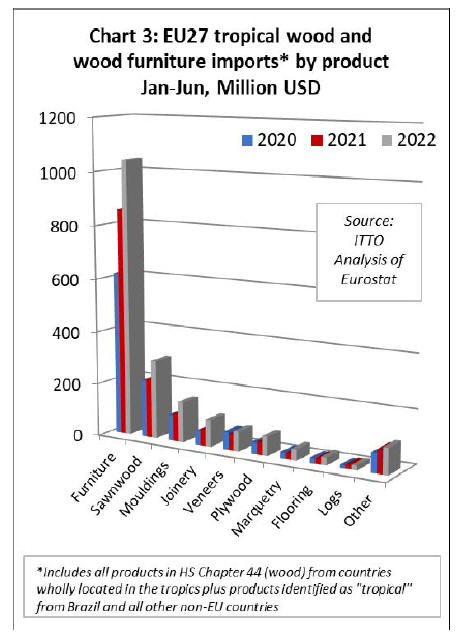
EU27 import value of tropical furniture rises
despite fall in quantity
In the first six months of 2022, EU27 import value of
wood furniture from tropical countries was US$1043M,
22% higher than the same period in 2021. However, in the
case of furniture, the increase in dollar value is entirely
due to the rise in freight rates and prices and the weakness
of the euro rather than an increase in export quantity. In
tonnage terms, imports actually declined 3% to 211,000
tonnes during the six month period.
In the first half of 2022, there were particularly large
increases in EU27 wood furniture import value from
Vietnam (+24% to US$444M) and Indonesia (+38% to
US$311M). More moderate gains were made in import
value from India (+2% to US$184M), Malaysia (+8% to
US$76M), Thailand (+7% to US$16M) and the
Philippines (+36% to US$6M). EU27 wood furniture
imports from all other tropical countries are negligible
(Chart 4).

EU27 imports of tropical sawnwood up 27%
After two slow years during the global pandemic, EU27
imports of tropical sawnwood have recovered ground this
year. Imports of 382,000 tonnes in the first six months
were 27% higher than the same period in 2021 and 31%
more than the same period in 2020. (Chart 5)
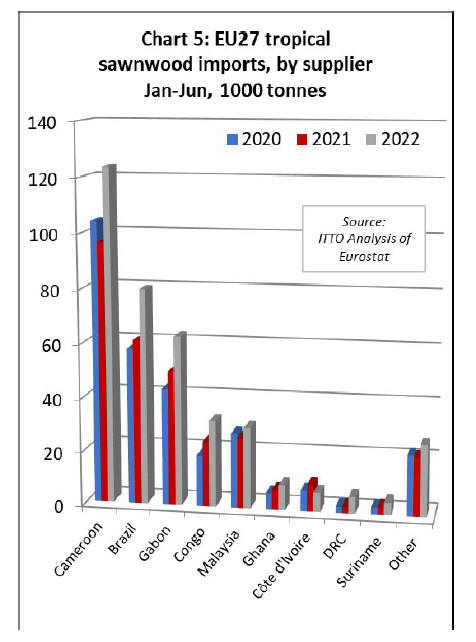
Sawnwood imports increased sharply in the first six
months of this year from all the largest tropical suppliers
to the EU27 including Cameroon (+28% to 123,700
tonnes), Brazil (+31% to 79,800 tonnes), Gabon (+26% to
62,800 tonnes), Congo (+32% to 32,100 tonnes) and
Malaysia (+15% to 30,000 tonnes).
Of smaller supply countries, there were large percentage
increases in imports from Ghana (+28% to 9,200 tonnes),
DRC (+154% to 6,100 tonnes), Suriname (+68% to 4,700
tonnes), Indonesia (+56% to 3,900 tonnes), Angola (+40%
to 3,200 tonnes), Peru (+18% to 2,700 tonnes), and CAR
(+307% to 2,000 tonnes). In contrast imports from Côte
d'Ivoire fell 29% decline to 7,000 tonnes.
Unlike sawnwood, EU27 imports of tropical
mouldings/decking were quite slow in the first half of this
year, most likely due to supply shortages rather than to
limited demand. Imports of 101,300 tonnes between
January and June this year were at the same level as the
same period last year.
Falling imports from the two largest supply countries,
Indonesia (-9% to 31,300 tonnes) and Brazil (-4% to
40,100 tonnes), were offset by rising imports from Peru
(+14% to 8,700 tonnes), Gabon (+72% to 7,000 tonnes),
Bolivia (+23% to 4,100 tonnes), and Malaysia (+8% to
4,100 tonnes) (Chart 6).
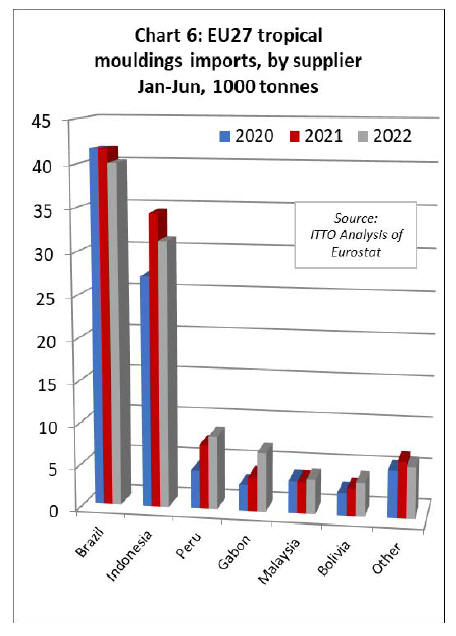
In the first six months of 2022, the EU27 imported 52,300
tonnes of tropical logs, 19% more than the same period in
2021. EU27 log imports increased from all three of the
largest African supply countries in the first six months of
this year compared to the same period last year;
Congo (+20% to 21,100 tonnes), DRC (+157 to 8,400
tonnes), and CAR (+13% to 8,000 tonnes). Imports also
increased sharply from negligible levels last year from two
South American countries, Guyana (+281% to 2,000
tonnes) and Paraguay (+343% to 1,200 tonnes). However,
log imports were down 48% to 3,600 tonnes from
Cameroon and down 46% to 3,100 from Liberia.
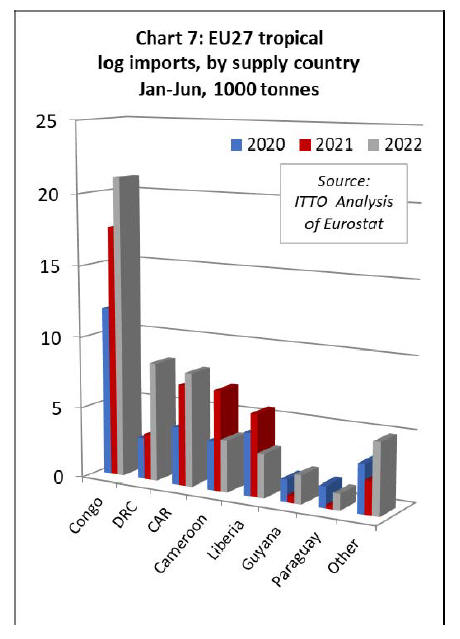
Gabon drives rebound in EU27 imports of tropical
veneer and plywood
In the first six months of 2022, the EU27 imported 78,500
tonnes of tropical veneer, 24% more than the same period
last year. Imports of tropical veneer from Gabon, by far
the largest supplier to the EU27, increased 30% to 42,900
tonnes.
There were also large gains in imports from Côte d'Ivoire
(+26% to 15,300 tonnes), Cameroon (+53% to 7,900
tonnes) and Equatorial Guinea (+111% to 2,100 tonnes).
After virtually no indirect trade in tropical veneer to the
EU27 via the UK last year, this trade totalled 1,500 tonnes
in the first six months of 2022.
These gains in EU27 tropical veneer imports were partly
offset by a 25% decline in imports from Congo to 4,000
tonnes (Chart 8).
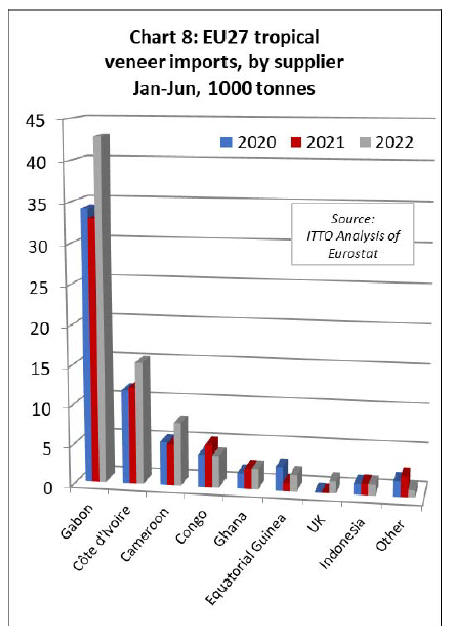
In the first six months of 2022, EU27 tropical plywood
imports of 67,600 tonnes were 23% more than the same
period the previous year. Imports from Indonesia, at
21,900 tonnes, were up 19% compared to the same period
last year. However, the biggest percentage increase was in
imports from Gabon, rising 76% to 15,300 tonnes.

Imports of tropical plywood also increased from Morocco
(+64% to 5,900 tonnes), Vietnam (+44% to 4,200 tonnes),
India (+66% to 3,200), Brazil (+65% to 2,600 tonnes) and
the UK (+15% to 2,100 tonnes). These gains offset a 36%
decline in imports of tropical hardwood faced plywood
from China to 7,500 tonnes, and a 64% fall in imports
from Malaysia to just 800 tonnes (Chart 9).
Rise in EU27 imports of tropical flooring from
Malaysia continues
In the first six months of 2022, the EU27 imported 13,700
tonnes of tropical wood flooring, 21% more than the same
period in 2021. The rise in EU27 wood flooring imports
from Malaysia, that began in 2020, has continued this
year.
Imports of 6,500 tonnes from Malaysia in the first six
months of 2022 were 19% more than the same period in
2021. There were also large gains, from a smaller base,
from Indonesia (+41% to 3,200 tonnes) and Vietnam
(+27% to 2,000 tonnes). However flooring imports from
Brazil have continued to slide this year, at just 900 tonnes
in the first six months, 17% down compared to the same
period last year (Chart 10).

The dollar value of EU27 imports of other joinery
products from tropical countries - which mainly comprise
laminated window scantlings, kitchen tops and wood
doors - increased 49% to US$155M in the first six months
of 2022.
Import value increased 38% to US$71M million from
Indonesia, 49% to US$45M from Malaysia, and 45% to
US$15M from Vietnam.
The apparent large increase in imports of this commodity
group from China, from negligible levels to US$9M in the
first six months of this year, is due to a change in product
codes from the start of this year allowing more joinery
products manufactured using tropical hardwood in nontropical
countries to be separately identified (Chart 11).
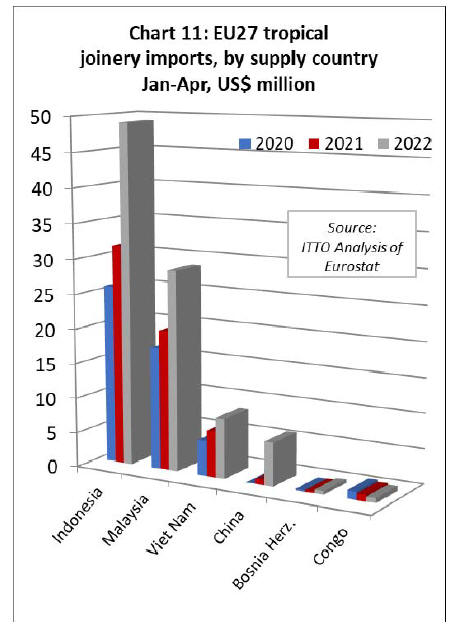
Unlike for furniture, the rise in import value for joinery
this year was not driven entirely by rising prices but was
also indicative of an increase in import quantity. In
quantity terms, the EU27 imported 58,300 tonnes of
tropical joinery products in the first six months of this
year, 35% more than the same period last year.
European Parliament Committee near unanimous
on deforestation law
On 12 July 2022, the Environment, Public Health and
Food Safety Committee of the European Parliament
adopted its position with 60 votes to 2 and 13 abstentions
on the Commission proposal for a regulation on
deforestation-free products to halt EU-driven global
deforestation.
The text of the Parliamentary Committee position, with
their recommendations for amendments to the text
proposed by the European Council in November last year,
can be downloaded at:
https://www.europarl.europa.eu/doceo/document/A-9-2022-0219_EN.pdf
Following near unanimous endorsement by the responsible
Parliamentary Committee, Plenary is expected to officially
adopt Parliament¡¯s position in September. After that
negotiations on the final law will begin with member
states.
The negotiation process will aim to agree a final version of
the law as a compromise between the Parliamentary text
and the text agreed on 28 June by the European Council -
which represents the Member States (see ITTO Market
Report 1st¨C15th July 2022, page 29).
According to the European Parliament press release issued
on adoption of the Committee's position, the new law
would make it obligatory for companies to verify (socalled
¡°due diligence¡±) that goods sold in the EU have not
been produced on deforested or degraded land. This would
assure consumers that the products they buy do not
contribute to the destruction of forests outside the EU and
hence reduce the EU¡¯s contribution to climate change and
biodiversity loss globally.
European MEPs also want companies to verify that goods
are produced in accordance with human rights protected
under international law and the rights of indigenous people
in addition to the relevant laws and standards in the
country where the products are produced.
The Commission¡¯s proposal covers cattle, cocoa, coffee,
palm-oil, soya and wood, including products that contain,
have been fed with or have been made using these
commodities (such as leather, chocolate and furniture).
Parliament wants to include pigmeat, sheep and goats,
poultry, maize and rubber, as well as charcoal and printed
paper products, and bring the cut-off date one year
forward, to 31 December 2019.
The Commission would have to evaluate, no later than two
years after the entry into force, whether the rules need to
be extended to other goods such as sugar cane, ethanol and
mining products, and how feasible this is. MEPs also want
them to cover other natural ecosystems such as grasslands,
peatlands and wetlands, if deemed appropriate by the
Commission, within one year after the entry into force.
Finally, MEPs also want financial institutions to be subject
to additional requirements to ensure that their activities do
not contribute to deforestation.
The European Parliament press release notes that "While
no country or commodity will be banned, companies
placing products on the EU market would be obliged to
exercise due diligence to evaluate risks in their supply
chain. They can for example use satellite monitoring tools,
field audits, capacity building of suppliers or isotope
testing to check where products come from. EU authorities
would have access to relevant information, such as
geographic coordinates. Anonymised data would be
available to the public".
The press release also states that "Based on a transparent
assessment, the Commission would have to classify
countries, or part thereof, into low, standard or high risk
within six months of entry into force of this regulation.
Imports from low risk countries will be subject to fewer
obligations".
American hardwood industry comment on EU
deforestation law
The American Hardwood Export Council (AHEC) has
issued a statement on the potential implications of the new
EU deforestation-free proposal for the US hardwood trade.
It is relevant for the tropical trade, firstly because
American hardwoods are key direct competitors in tropical
hardwoods in a wide range of European wood applications
and secondly because there are close parallels between the
supply chains for tropical and American hardwoods, both
of which derive primarily from managed semi-natural
forest rather than plantations.
Drawing on information on the specific characteristics of
these supply chains, the statement raises issues on the
practical implications of the ¡°geolocation¡± requirement
specifically for wood sourced from diverse semi-natural
forests where forest ownership is highly fragmented.
According to the AHEC statement ¡°More than 90% of
U.S. hardwood supply derives from low-intensity
harvesting of diverse semi-natural forest by non-industrial
owners, mainly individuals and families¡±.
In such circumstances, AHEC suggest that supply of
commercial volumes of hardwood of widely different
grades, colours and textures requires that wood be
aggregated from a large number of smallholders over a
lengthy period of time, a process which inevitably
involves a lot of mixing from different smallholders.
Although each of these smallholders will generally be
within a 25 to 150 mile radius of each mill, a problem
arises for American hardwoods because each
¡°geolocation¡± must refer to a ¡°plot of land¡± defined in the
draft Regulation as ¡°within a single real-estate property¡±.
AHEC notes that ¡°because harvest volumes from each plot
of land are so small, a typical hardwood mill needs to
purchase logs from as many as several hundred forest
owners each year¡±.
AHEC go on to suggest that ¡°under the current draft
legislation, even a small U.S. hardwood mill would likely
be under an obligation to provide a list of at least several
tens, and probably hundreds, of geolocations to identify
the ¡®plots of land¡¯ from which wood in each individual
consignment might be derived.
An exporter operating a concentration yard ¨C purchasing
from a range of sawmills and where additional sorts are
often made to ensure each customer is supplied with wood
of specific species, quality, size, and color ¨C will be
required to provide a list of several hundred, perhaps even
thousands, of plots of land with each consignment¡±.
As a result the AHEC statement suggests that ¡°In practice,
linking all these geolocations with individual
consignments would quickly overwhelm the management
systems of even the largest most sophisticated companies,
let alone the relatively small, often family-run, enterprises
that predominate in the U.S. hardwood sector¡±.
AHEC contrasts this situation with ¡°a large industrial
operation, dependent on state concessions or company
owned lands, where each ¡®plot of land¡¯ extends to
thousands of hectares, and each harvest comprises singleaged
monocultures. It should be obvious this type of large
industrial operation gains a clear competitive advantage
from the geolocation requirement as currently set out in
the draft EU law¡±.
AHEC also suggest that ¡°If the regulation is adopted in its
current form, the only American hardwood lumber likely
to be available to EU buyers will be the around 10% of
production from state-owned forest and the few areas of
large industry lands. Log exports will be less affected, and
in fact will be encouraged at the expense of lumber
exports as the need for sorting and grading is much less¡±.
AHEC believe that this potential issue with the law could
be ¡°readily resolved through some minor amendments to
the EU¡¯s legal text¡±, specifically that ¡°rather than linking
to a single real estate property, the definition of ¡®plot of
land¡¯ needs to be adaptable to the wide range of
circumstances prevailing in the supply of the regulated
commodities.
For non-industrial forest owners, a suitable definition
would be to a specific jurisdiction, co-operative, or
community where there is a demonstrably low risk of
illegal harvest or deforestation¡±.
To link specific products with a low risk jurisdiction,
AHEC say that they are ¡°currently facilitating
development of a new certification framework specifically
designed for low-intensity non-industrial hardwood
operations. The framework is based on third party
assessment of risk at jurisdictional level (individual state
in the case of US) in accordance with a ¡®Jurisdictional
Risk Assessment¡¯ (JRA) standard which will assess
specific risk of illegality, deforestation, forest degradation,
plus non-conformance to a wider range of sustainable
forestry principles¡±.
According to AHEC, ¡°The certification system links with
ideas pioneered in the EU FLEGT initiative to build robust
governance at jurisdictional level. It requires and builds on
increasingly accessible and good quality forest inventory
data. It also links with a World Forest ID project to
prepare a comprehensive database of US hardwood
samples from across the US for Stable Isotope Ratio
Analysis (SIRA). This will allow a regular check of the
overall integrity of the system¡±.
The AHEC statement is available at:
https://www.americanhardwood.org/sites/default/files/reports/download/2022-08/AHEC%20Comment%20on%20EU%20Deforestation%20Law.pdf
|